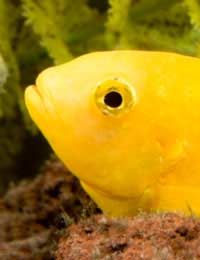Cichlids

Vividly coloured and highly varied cichlids are some of the most truly exotic fish you can keep in your aquarium. They are noted for their intelligence and are highly sociable, making them very rewarding fish to interact with. They are also comparatively easy to breed.
The first thing you need to be aware of when keeping cichlids is that they can get big - in the case of some species, up to three feet long! Because of this, and because they are mostly community fish, you'll need to have plenty of space for them. You'll also need to make sure you get the ph of the water right, as some species of cichlids come from environments with unusual water chemistry and will struggle in a neutral aquarium. Most species are happiest when they have plenty of places to hide, especially enjoying caves. Make sure you have a background picture behind your tank to give an illusion of cover, as a blank wall will make your cichlids nervous, believing they could be attacked from that side.
Despite being sensitive fish in other ways, cichlids are comparatively easy to feed and will accept most commercial fish food preparations as well as enjoying live food. For best results, try to provide them with a varied diet.
Types of Cichlid
There are numerous types of cichlid to choose from, many of them beautiful to look at, but there are a lot of other factors you need to take into account when choosing the right one for your aquarium.- Blue Texas Cichlids - Comparatively hardy and adaptable, these are a great species to start off with. They are fond of digging and will quickly uproot plants.
- Convicts - These distinctive stripy fish are among the most popular aquarium species they grow to just four or five inches long and are notably easy to breed.
- Red Devils - Brilliantly coloured, these fish are highly active, but this may sometimes sill over into aggression. They enjoy digging up plants.
- Jaguars -With truly exotic markings, these can make an impressive contribution to a community tank, but they are usually too aggressive to keep with others of their own species and sex.
- Dickfeldi's Slender Cichlids -Small and non-aggressive, these fish are best kept in pairs. They don't require a lot of space and can do well in community tanks.
Breeding Cichlids
One of the reasons why cichlids are so enduringly popular with aquarists is their fascinating breeding behaviour. You'll probably first realise your cichlids are ready to breed when their colours get brighter and they begin to chase one another. Males will expend a great deal of energy driving off rivals and trying to impress females, as well as burrowing to prepare suitable nest spots for eggs to be laid. Despite all this care, however, cichlids often eat their own eggs. It is unwise to try to remove the adults to prevent this, as doing so can cause extreme stress. If it happens, be patient. Your cichlids will soon get it right, and once the fry hatch out they will be protective parents.Some species of cichlids construct hiding places for their young, whilst others protect them inside their own mouths. Because of this, they can be successful at raising them even in community tanks where there are predatory fish. However, you should be aware that their protective instincts will make them more aggressive towards your other fish, so make sure there's plenty of room within the tank for fish who feel threatened to get away.
For all the difficulties involved, keeping cichlids can be extremely rewarding. Always active and interested in their surroundings, they'll provide you with plenty to watch, and they are among the most beautiful fish available for the home aquarium.


Re: Providing Toys for Your Fish
Toys for my baby Flowerhorn fish??? And where to buy them ?
Re: Snail Infestations in Your Fish Tank
My coy fish just started darting and running into the glass. I've checked them over and see nothing on the outside of…
Re: My Pet Fish is 20 Years Old is this a Record?
I purchased a gold fish on April 1997 for my daughters and the same fish is alive and well. The reason I'm…
Re: Dealing with Bullying Between Fish
I have 3 Bolivian butterfly rams not sure the genders,but at the start all 3 were fine but just recently we’ve notice 2…
Re: Using Electrical Devices Safely In Your Aquarium
Monthly water changes isn’t enough I would be changing at least a 1/3 weekly. I do it more often than…
Re: Dealing with Bullying Between Fish
I have a blue gourami that has been living with 4 platty’s and a yoyo loach. I noticed a couple of my fish missing. I…
Re: Lighting for Aquatic Animals
Will a UV submersible light harm my tropical tank and fish. Thanks for any help
Re: Dealing with Bullying Between Fish
Recently put 12 new Africans in my 55 gallon tank. Many rocks and hiding places. After 2,3 days one of them, obliquidens,…
Re: Food Quantities
Just noticed smallest neon tetra tail is missing and white on the edges. Another also has half of tail missing. They was OK a few days ago. I only…
Re: Providing Toys for Your Fish
I have guppies and I think the ideas for toys might be too big, I have tried training them but they aren't responding.